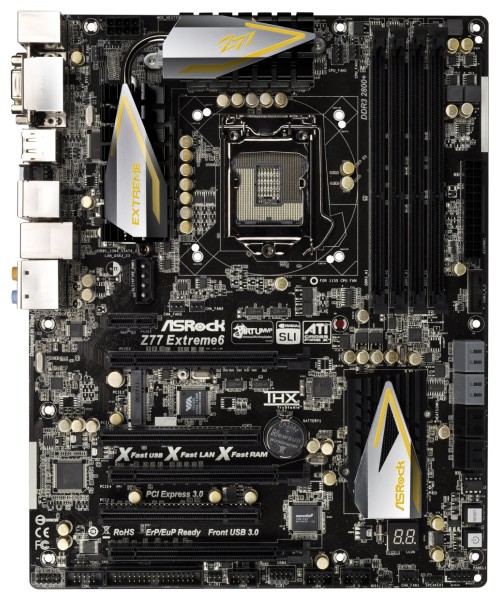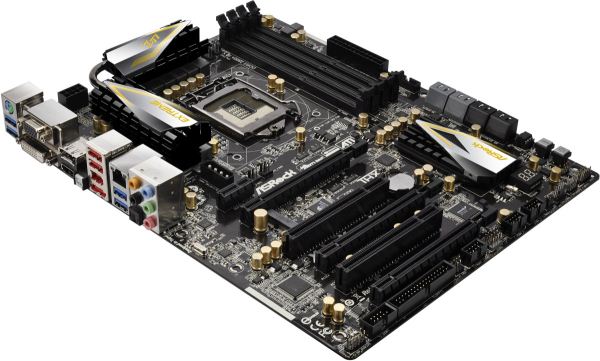Intel Z77 Panther Point Chipset and Motherboard Preview – ASRock, ASUS, Gigabyte, MSI, ECS and Biostar
by Ian Cutress on April 8, 2012 12:00 AM EST- Posted in
- Motherboards
- Intel
- Biostar
- MSI
- Gigabyte
- ASRock
- Asus
- Ivy Bridge
- ECS
- Z77
ASRock Z77 Extreme6—Visual Inspection
With the Extreme6, compared to the Extreme4, there are a significant number of changes, both visual and in terms of features. For a start, the heatsink design is more pronounced, using something similar to their X79 range in terms of black and gold ridged and edged surfaces. The VRM heatsink design is more substantial than the Extreme4, even though online it states it is still only an 8 + 4 VRM design—actually looking at the board, it seems more of a 10 + 4 design.
By looking at the motherboard, you would assume that it would support three-GPU setups. Unfortunately, this third full-length PCIe lane is only PCIe 2.0 x4, rather than splitting up the PCIe 3.0 lanes x8/x4/x4 or using a PLX chip. The MSRP for this board should be around $177, indicating that perhaps that is too cheap a board for one of the expensive PCIe 3.0 expansion PLX chips.

Onboard is also an mSATA port, right in the middle between the first PCIe slot and the PCI slot. Above the PCIe slots is a 4-pin molex power connector to provide extra power to the PCIe slots, although I am kind of getting tired of seeing it put in this location. If anything, it should be at the bottom end or beside the 24-pin power connector, as having it above the PCIe slots just means that there will be cables all over the place.
One other less obvious change to the Extreme4 is that there is a Floppy drive header on board. Yes, you heard me right—floppy drive! It seems odd now to include this legacy connection. It still has a place in industrial concepts (where a machine uses floppy drives and costs 1000x more than the PC processing its data), but not particularly on a higher end product which may be geared towards gaming and overclocking. Perhaps if ASRock are the only ones, then it creates a niche just for them.
In terms of fan headers on board, we have one three-pin beside the 8-pin 12V power connector, two CPU headers (one 4-pin, one 3-pin) just to the right of the top heatsink, two chassis three-pin headers beside the molex connector, and another 4-pin chassis header on the bottom of the board. On the right hand side, the USB 3.0 connector has been placed beneath the 24-pin ATX power connector, followed by the SATA ports. Like the Extreme4, we have the PCH SATA ports (two SATA 6 Gbps and four SATA 3 Gbps) and two extra SATA 6 Gbps from an ASMedia ASM1061 controller.
Around the larger chipset heatsink, we have power/reset buttons and a two digit debug display, both of which I personally like to see as a reviewer (makes my job a bit easier) but also helps overclockers. On the south side of the board, apart from that floppy connector I mentioned, we have a COM port, front panel audio, and an array of USB 2.0 headers.
PCIe layout is similar to the Extreme6, with a PCIe x1, PCIe 3.0 x16/x8, an mSATA connector, PCI, PCIe 3.0 x8, PCI, and a PCI 2.0 x4. This allows a user to use a dual GPU setup, and still have access to a PCIe x1 and x4.

Aside from the bowed picture from ASRock, we have something similar to the Extreme4 for the IO back panel, though this time with a DisplayPort output. From left to right, we have a combination PS/2 port, two USB 3.0 ports (blue), a D-Sub port, DVI-D, DisplayPort, HDMI, a ClearCMOS button, two USB 2.0 (red), an IEEE1394 port, eSATA, gigabit Ethernet, two more USB 3.0 (blue), and audio outputs including an optical SPDIF.
Board Features
| ASRock Z77 Extreme6 | |
| Size | ATX |
| CPU Interface | LGA-1155 |
| Chipset | Intel Z77 |
| Power Delivery | 8 + 4 |
| Memory Slots |
Four DDR3 DIMM slots supporting up to 32 GB Up to Dual Channel, 1066-2800 MHz |
| Video Outputs | DisplayPort, HDMI 1.4a, DVI-D, D-Sub |
| Onboard LAN | Broadcom BCM57781 |
| Onboard Audio | Realtek ALC898 |
| Expansion Slots |
2 x PCIe x16 Gen3 (x16, x8/8) 1 x PCIe x16 Gen2 (x4) 1 x PCIe x1 Gen2 2 x PCI 1 x mini PCIe |
| Onboard SATA/RAID |
2 x SATA 6 Gbps (PCH), Support for RAID 0, 1, 5, 10 2 x SATA 6 Gbps (ASMedia ASM1061) 4 x SATA 3 Gbps (PCH), Support for RAID 0, 1, 5, 10 |
| USB |
Two USB 3.0 at rear (PCH) Two USB 3.0 at rear (Etron EJ168A) One USB 3.0 header (PCH) |
| Onboard |
4 x SATA 6 Gbps 4 x SATA 3 Gbps 1 x Floppy Connector 1 x IR Header 1 x CIR Header 1 x COM Header 1 x SPDIF Header 1 x 4-pin Molex power connector Power/Reset Buttons Two Digit Debug LED 6 x Fan Headers Front panel audio connector 3 x USB 2.0 headers (support 6 USB 2.0 ports) 1 x USB 3.0 header (supports 2 USB 3.0 ports) |
| Power Connectors |
1 x 24-pin ATX connector 1 x 8-pin 12V connector 1 x 4-pin Molex for PCIe |
| Fan Headers |
2 x CPU Fan Header (one 4-pin, one 3-pin) 3 x CHA Fan Headers (one 4-pin, two 3-pin) 1 x SYS Fan Header (one 3-pin) |
| IO Panel |
1 x Combo PS/2 Port 1 x DisplayPort 1 x HDMI 1.4a 1 x DVI-D 1 x D-Sub 1 x Optical SPDIF 2 x USB 2.0 4 x USB 3.0 1 x IEEE1394 1 x Gigabit Ethernet 1 x Clear CMOS Audio Outputs |
| Warranty Period | 3 years from date of purchase |
| Product Page | Link |
Nothing immediately jumps out from the board features list aside from the differences to the Extreme4. This is a quite good package for an MSRP of $171.











145 Comments
View All Comments
Springf - Sunday, April 8, 2012 - link
Quote: Native USB 3.0The other long awaited addition found on Panther Point is the native implementation of USB 3.0 that comes directly from the chipset. The chipset will only provide two USB 3.0 ports,
------- end quote
I think Z77 natively support 4 USB 3.0 ports
http://www.intel.com/content/dam/www/public/us/en/...
C'DaleRider - Sunday, April 8, 2012 - link
When you write sentences like this:"ASUS have a lot to live up to with its Ivy Bridge Pro board."
You do realize that you're mixing a plural verb and singular pronoun for the same damn thing...Asus in this case. First, you use a plural verb talking about Asus and then use a singular pronoun for Asus in the same sentence. You cannot do both; well, I guess you can, but you show you have no clue about English grammar and look like you dropped out of third grade.
Get a copy editor! How can anyone take this site a professional when the writing borders on illiterate?
sausagestrike - Sunday, April 8, 2012 - link
You should higher a sand removal specialist to take a look at you're twat.Arbie - Monday, April 9, 2012 - link
@C'DaleRider -You do realize that... you're the illiterate one, don't you?
"ASUS have" is perfectly legitimate English, and is in fact what you will hear in England itself. "ASUS" is a company of people and can be taken as singular or plural.
For me, the AT editors just made major points right in this set of comments by correcting another ignoramus, who was misusing "begs the question".
Now, can we get back to fan headers?
Iketh - Tuesday, April 10, 2012 - link
no, there are errors STILL all over the place in this article... it's horrid... when your site is 99% words, please make them as easy as possible to comprehend...PLEASE LEARN TO WRITE LIKE ANAND, THX!
Anand, for the love of god, pay a little more to hire a little more education (SEE WHAT I DID THAR??)
nz_nails - Monday, April 9, 2012 - link
"Biostar have unfortunately put much effort in here, with only three to play with..."Should be a "not" in there I suppose.
s1lencerman - Monday, April 9, 2012 - link
I do not understand why non express PCI slots are still on boards. The only one to see the light is MSI, and if they had a bit better performance I would switch from ASUS for my next mobo in a heartbeat. Also, why do these boards have a VGA connector (D-sub)? Intel HD graphics can only support 2 displays max, and if you have more than you should get a dedicated graphics card anyway, and probably already have. I don't see the point.Another thing, when will OEMs start putting the USB hub at the bottom of the board facing down and not away from the board. If you have multiple cards on the board then you can get really cramped really fast when you are trying to use those.
I'm sorely tempted to just wait another year or so till there is a board with these features and over 50% SATA 6G/s, but we'll see if that even comes out in that short of time.
DanNeely - Monday, April 9, 2012 - link
1) Some customers are asking for them. Customer demand was why a few boards started sporting floppy controllers again last summer. Legacy PCI demand is almost certainly much higher.2) Intel doesn't have enough PCIe lanes on the southbridge for well featured ATX boards.
2.1) This means a bridge chip of some sort.
2.2) PCIe devices are used to being able to count on the full 250/500MBps bandwidth.
2.3) Legacy PCI devices are used to sharing their bandwidth (133MBps).
2.4) 2.2 and 2.3 combined mean there's less risk of compatibility problems in filling out a few slots with legacy PCI slots.
This is probably going to remain an issue until either:
A) Intel increases the number of lanes they offer on their boards by a half dozen or so (bridges are also used for on board devices).
B) Intel integrates a lot more stuff into the southbridge so it doesn't need PCIe lanes: More USB3, Sata6GB, audio, ethernet.
C) A new version of PCIe allows sizes other than powers of two. Fitting everything on would be much easier if a board maker could fall back on just offering 13/1x or 7/7x on the main gfx slots.
jfelano - Monday, April 9, 2012 - link
GReat to see Asrock finally stepping up with the warranty, great products.James5mith - Monday, April 9, 2012 - link
Something I realized by reading this roundup:Almost all of the current motherboards are using PCI connected Firewire chips. Even the ones that have PCIe connected firewire use TI chips, which in turn are still PCI firewire, with an internal PCI to PCIe translator.
After some research the only native PCIe firewire controller I've found is from LSI. Does anyone else know of another solution? This is an interesting "dirty secret" that I never really paid any attention to.